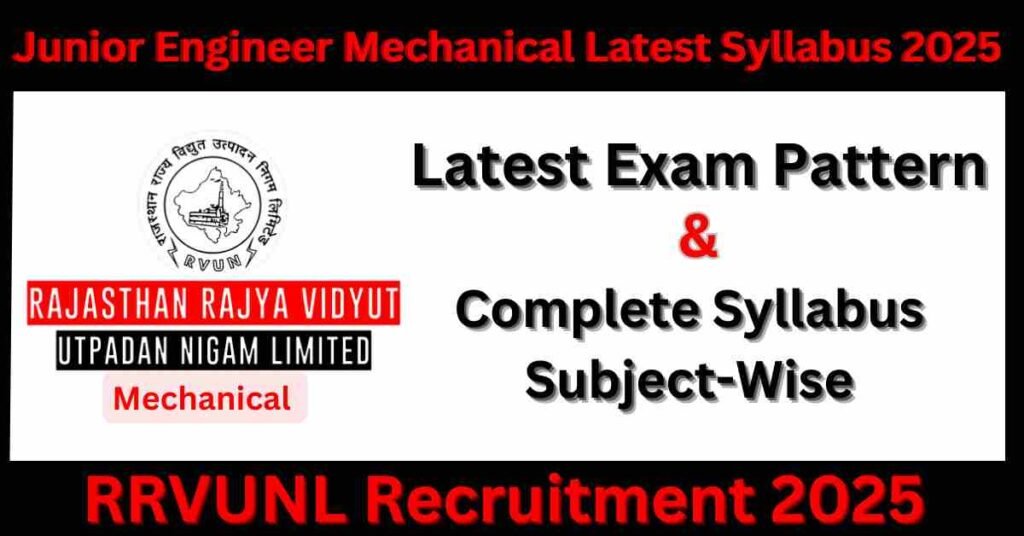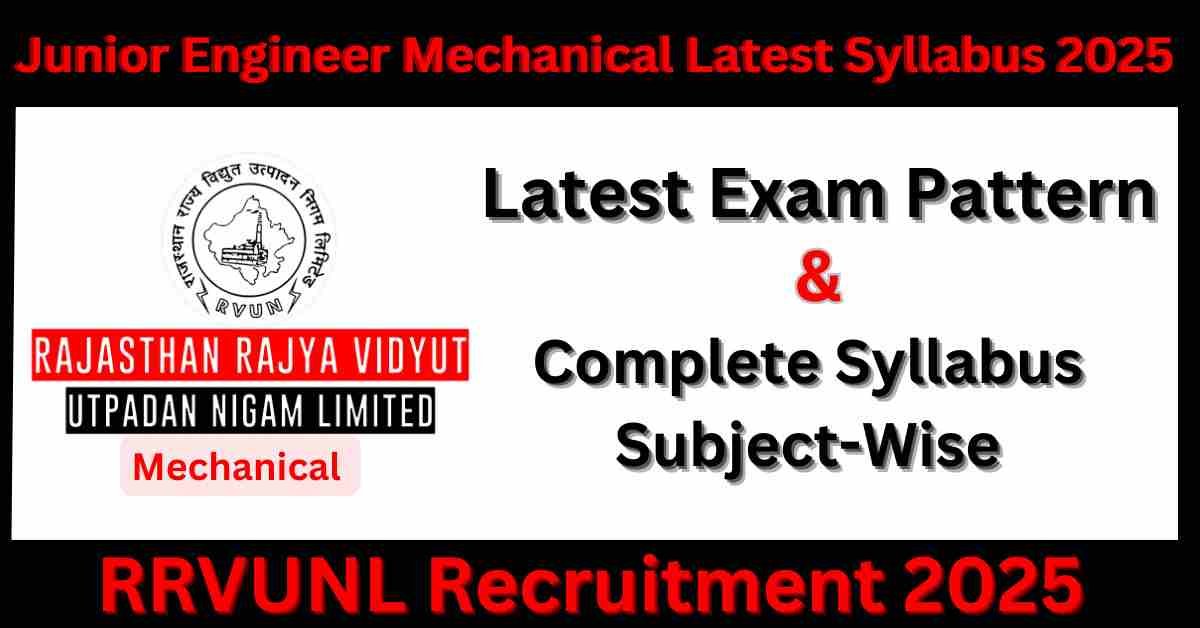RRVUNL Junior Engineer Mechanical Latest Syllabus: The Rajasthan Rajya Vidyut Utpadan Nigam Limited has recently released the notification for the post of Junior Engineer Mechanical. The total number of vacancies available for this post is 25. The candidates who are interested in this examination can apply from 30 January 2025 to 20 February 2025.

Important Dates for RRVUNL Junior Engineer Mechanical Latest Syllabus 2025
Here, are the important dates for the examination of the RRVUNL Junior Engineer Mechanical Latest Syllabus as follows-
- Application Starts: 30/01/2025
- Last Date: 20/02/2025
- RVUNL Exam Date : As per Schedule
Selection Process for RRVUNL Junior Engineer Mechanical 2025
Here, is the selection process for RRVUNL Junior Engineer Mechanical Latest Syllabus as follows-
- Medical Examination
- Written Exam
- Document Verification
Exam Pattern for RRVUNL Junior Engineer Mechanical 2025
Here, is the exam pattern for RRVUNL Junior Engineer Mechanical Latest Syllabus 2025 as follows-
- Mode: Offline (Pen and Paper-based)
- Duration: 2 hours (120 minutes)
- Total Questions: 140
- Total Marks: 200
- Negative Marking: 1/3 mark deducted for each incorrect answer
- Part B Weightage: 40%
Here, is the Part A and Part B for the exam pattern of RRVUNL Junior Engineer Mechanical Latest Syllabus as-
Part A: Core Subject (Mechanical Engineering)
- Part A: Weightage: 60%
- Number of Questions: 60
- Total Marks: 120
Part B: General Knowledge and Aptitude
- Part A: Weightage: 60%
- Number of Questions: 60
- Total Marks: 120
| Subject | No. of Question | Total Marks |
| General Knowledge and Aptitude | 80 | 80 |
| Reasoning and Mental Ability | 08 | 08 |
| General Knowledge and Everyday Science (Rajasthan) | 36 | 36 |
| General Knowledge and Everyday Science (World, India, Science) | 12 | 12 |
| Hindi General | 8 | 8 |
| English General | 8 | 8 |
| Mathematics | 8 | 8 |
RRVUNL Junior Engineer Mechanical Latest Syllabus and Exam Pattern 2025
Here, the subject-wise description of RRVUNL Junior Engineer Mechanical Latest Syllabus as follows-
1. सामान्य ज्ञान और सामान्य विज्ञान (General Knowledge and General Science):
- वर्तमान घटनाएँ (Current Affairs): राष्ट्रीय और अंतर्राष्ट्रीय समाचार, नवीनतम नियुक्तियाँ, खेल, पुरस्कार, आदि।
- राजस्थान से संबंधित प्रश्न (Questions related to Rajasthan): राज्य की भूगोल, इतिहास, संस्कृति, राजनीति, अर्थव्यवस्था, खेल, आदि।
- भूगोल (Geography): विश्व और भारत का भूगोल, जलवायु, प्राकृतिक संसाधन, आदि।
- इतिहास (History): प्राचीन, मध्यकालीन और आधुनिक भारत का इतिहास, स्वतंत्रता संग्राम, आदि।
- भारतीय राजनीति (Indian Politics): संविधान, संसद, चुनाव प्रक्रिया, राजनीतिक दल, आदि।
- अर्थशास्त्र (Economics): मौलिक आर्थिक सिद्धांत, भारतीय अर्थव्यवस्था, योजनाएँ, आदि।
- खेल (Sports): प्रमुख खेल, टूर्नामेंट, रिकॉर्ड, आदि।
- बुनियादी कंप्यूटर (Basic Computer): कंप्यूटर की मूल बातें, इंटरनेट, MS Office, आदि।
- सरकारी योजनाएँ (Government Schemes): केंद्र और राज्य सरकार की प्रमुख योजनाएँ।
2. तर्कशक्ति और मानसिक क्षमता (Reasoning and Mental Ability):
- डेटा पर्याप्तता (Data Sufficiency): दिए गए डेटा के आधार पर प्रश्नों का समाधान।
- श्रृंखला परीक्षण (Series Test): संख्याओं या अक्षरों की श्रृंखला में पैटर्न पहचानना।
- पहेलियाँ (Puzzles): तार्किक पहेलियाँ और समस्याएँ।
- डेटा व्याख्या (Data Interpretation): तालिकाओं, ग्राफ़, आदि से डेटा का विश्लेषण।
- समानताएँ (Analogies): शब्दों या संख्याओं के बीच समानताएँ।
- दिशा और दूरी (Direction and Distance): दिशा-निर्देशों और दूरी से संबंधित प्रश्न।
- बैठक व्यवस्था (Sitting Arrangement): व्यक्तियों की बैठने की व्यवस्था पर आधारित प्रश्न।
- पैसेज और निष्कर्ष (Passage and Conclusion): दिए गए पाठ के आधार पर निष्कर्ष निकालना।
- रैंकिंग और समय अनुक्रम (Ranking and Time Sequence): व्यक्तियों की रैंकिंग या घटनाओं का समय अनुक्रम।
- वर्गीकरण (Classification): वस्तुओं या शब्दों का वर्गीकरण।
- निर्णय-निर्माण क्षमता (Decision-Making Ability): दिए गए परिदृश्यों पर निर्णय लेना।
- वाक्य और तर्क (Statement and Argument): दिए गए वाक्यों और उनके तर्कों का विश्लेषण।
- वाक्य और अनुमानों (Statement and Assumptions): दिए गए वाक्यों और उनके अनुमानों का मूल्यांकन।
- इनपुट / आउटपुट (Input / Output): कंप्यूटर आधारित इनपुट-आउटपुट प्रक्रियाएँ।
- कोडिंग-डिकोडिंग (Coding-Decoding): शब्दों या संख्याओं को कोड और डिकोड करना।
- वर्णमाला परीक्षण (Alphabet Test): वर्णमाला से संबंधित प्रश्न।
- चित्र श्रृंखला (Figure Series): चित्रों की श्रृंखला में पैटर्न पहचानना।
- रक्त संबंध (Blood Relations): परिवारिक संबंधों पर आधारित प्रश्न।
- अक्षर और प्रतीक श्रृंखला (Letter and Symbol Series): अक्षरों और प्रतीकों की श्रृंखला में पैटर्न पहचानना।
- अधिकार और तर्क (Assertion and Reasoning): दिए गए कथनों और उनके कारणों का विश्लेषण।
- कारण और प्रभाव (Cause and Effect): घटनाओं के कारण और उनके प्रभावों का मूल्यांकन।
- तार्किक व्याख्या (Logical Deduction): तार्किक रूप से निष्कर्ष निकालना।
3. गणित (Mathematics):
- परम्यूटेशन और संयोजन (Permutation and Combination): वस्तुओं की व्यवस्था और चयन।
- कलन (Calculus): सीमाएँ, अवकलन, समाकलन, आदि।
- बाइनोमियल प्रमेय (Binomial Theorem): बाइनोमियल विस्तार और गुणांक।
- लाभ और हानि (Profit and Loss): व्यापारिक लाभ और हानि की गणना।
- साधारण और चक्रवृद्धि ब्याज (Simple and Compound Interest): ब्याज की गणना।
- प्रतिशत (Percentage): प्रतिशत की गणना और अनुप्रयोग।
- अनुपात और समानुपात (Ratio and Proportion): अनुपात और समानुपात की समस्याएँ।
- मिश्रण और आरोपण (Mixture and Allegation): मिश्रण की समस्याएँ।
Also Read: CSIR IMMT JSA Latest Syllabus and Exam Pattern 2025
Official Website: Rajasthan Energy Official Website
